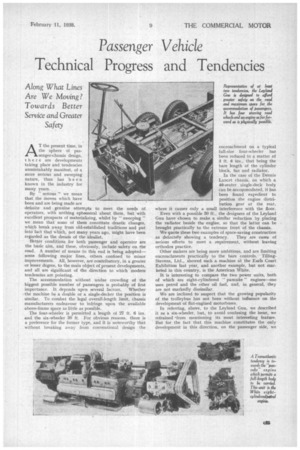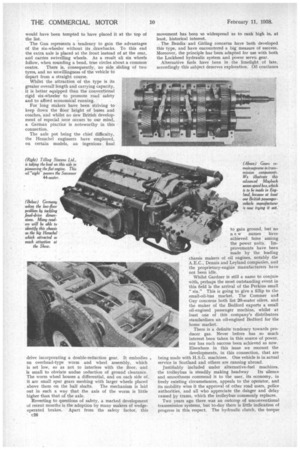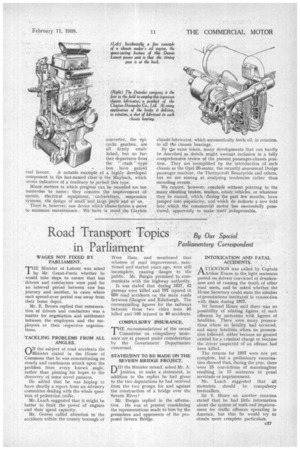Passenger Vehicle Technical Progress and Tendencies
Page 75

Page 76

Page 77

If you've noticed an error in this article please click here to report it so we can fix it.
Along What Lines Are We Moving? Towards Better Service and Greater
Safety
AT the present time, in the sphere of passenger-chassis design, t h ere are developments taking place and tendencies unmistakably manifest, of a more serious and sweeping nature, than has been known in the industry for many years.
By " serious " we mean that the moves which have been and are being made are definite and genuine attempts to meet the needs of operators, with nothing ephemeral about them, but. with excellent prospects of materializing, whilst by " sweeping " we mean that some of them constitute drastic changes, which break away from old-established traditions and put into fact that which, not many years ago, might have been regarded as the drealn of the idealist.
Better conditions for both passenger and operator are the basic aim, and these, obviously, include safety on the road. A number of means to this end is being adopted— some following major lines, others confined to minor improvements. All, however, are contributory, in a greater or lesser degree, to the main object of present developments, and all are significant of the direction to which • modern tendencies are pointing.
The accommodation without undue crowding of the biggest possible number of passengers is probably of first importance. lt depends upon several factors. Whether the machine be a double or a single-decker the position is similar. To combat the legal overall-length limit, chassis manufacturers endeavour to infringe upon the available above-frame space as little as possible. .
The four-wheeler is permitted a length of 27 ft. 13 ins, and the six-wheeler 30 ft. For obvious reasons, there is a preference for the former type, and it is noteworthy that without breaking away from conventional design the encroachment on a typical full-size four-wheeler has been reduced to a matter of 3 ft 6 ins., that being the hare length of the cylinder block, fan and radiator.
In the case of the Dennis Lancet chassis, on which a 40-seater single-deck. body Can be accommodated, it has. been found expedient to position the engine distribution gear at the rear, where it causes only a small interference with the floor.
Even with a possible 30 ft., the designers of the Leyland Gnu have chosen to make a similar reduction by placing the radiator beside the engine, so that the latter can be brought practically to the extreme front of the chassis.
We quote these two examples of space-saving construction as definitely showing a tendency. They are cases of serious efforts to meet a requirement, without leaving orthodox practice.
Other makers are being more ambitious, and are limiting encroachments practically to the bare controls, TillingStevens, Ltd., showed such a machine at the Earls Court Exhibition last year, and another example, but not marketed in this country, is the American White.
It is interesting to compare the two power units, both of which are eight-cylindered " pancake " engines—one uses petrol and the other oil fuel, and, in general, they are not markedly dissimilar.
We are inclined to suspect that the growing popularity of the trolleybus has not been without influence on the development of flat-engined motorbuses.
In referring, above, to the Leyland Gnu, we described it as a six-wheeler, but, to avoid confusing the issue, we refrained 'from mentioning its most interesting feature. But for the fact that this machine constitutes the only development in this direction, on the passenger side, we would have been tempted to have placed it at the top of the list.
The Gnu represents a tendency to gain the advantages of the six-wheeler without its drawbacks, To this end the extra axle is placed at the front instead of at the rear, and carries swivelling wheels. As a result all six wheels follow, when rounding a bend, true circles about a common centre. There is, consequently, no side sliding of two tyres, and no unwillingness of the vehicle to depart from a straight course.
Whilst the attraction of the type is its greater overall length and carrying capacity, it is better equipped than the conventional rigid six-wheeler to promote road safety and to afford economical running. , For long makers have been striving to keep down the floor height of buses and coaches, and whilst no new British development of especial note occurs to our mind, a German practice is noteworthy in this connection.
The axle pot being the chief difficulty, the Henschel engineers have employed, on certain models, an ingenious final drive incorporating a double-reduction gear. It embodies , an overhead-type worm and wheel assembly, which is set low, so as not to interfere with the floor, and is small to obviate undue "eduction of ground clearance. The worm wheel houses a differential, and on each side of. it are small spur gears meshing with larger wheels placed above them on the half shafts. The mechanism is laid out in such a way that the axis of the worm is little higher than that of the aide.
Reverting to questions of safety, a marked development of recent months is the adoption by many makers of wedgeoperated brakes. Apart from the safety factor, this c26
movement has been so widespread as to rank. high in, at least, historical interest.
The Bendix and Girling concerns have both developed this type, and have encountered a big measure of success. Moreover, the principle has been adapted for use with both the Lockheed hydraulic system and power servo gear.
Alternative fuels have been in the limelight of late. accordingly this subject deserves exploration. Oil continues to gain ground, but no n e w names have achieved fame among the power units. Improvements have been made by the leading chassis makers of oil engines, notably the A.E.C., Dennis and Leyland companies, and the proprietary-engine manufacturers have not been idle.
Whilst Gardner is still a name to conjure with, perhaps the most outstanding event in this field is the arrival of the Perkins small " six." This is going to give a fillip to the small-oil-bus market. The Commer and Guy concerns both list 20-seater oilers, and the maker of the Bedford exports a small oil-engined passenger machine, whilst at least one of this company's distributors standardizes an oil-engined Bedford for the home market.
There is a definite tendency towards producer gas. Never before has so much interest been taken in this source of power, nor has such success been achieved as now. Elsewhere in this issue we recount the developments, in this connection, that are being made with H.S.G. machines. One vehicle is in actual service in Scotland and others are running abroad.
Justifiably included under alternative-fuel machines, the trolleybus is steadily making headway Its silence and smoothness commend it to the user, its economy, in freely existing circumstances, appeals to the operator, and its mobility wins it the approval of other road users, police authorities, and all who• appreciate the danger and delay caused by trams, which the trolleybus commonly replaces.
Two years ago there was an outcrop of unconventional transmission systems, but to-day there is little indication of progress in this respect. The hydraulic clutch, the torque converter, the epicyclic gearbox, are all firmly established, but no further departures from the "crash "-type — box have gained A notable example of a highly developed component in the last-named class is the Maybach, Which seems indicative of a tendency to perfect' this type. Minor matters in which progress can be recorded are too numerous •to name; they concern the improvement of metals, electrical equipment, carburetters, suspension systems, the design of small' and large parts and scr on
There is, however, one device which characterizes a move to minimin maintenance.We .haVe in mind the Clayton
Teal favour. chassis lubricator, which automatically feeds oil, in rotation, to all the chassis bearings.
By the same token, many developments that can hardly he described as details might warrant inclusion in a fully comprehensive review of the present passenger-chassis position. They are exemplified by the introduction of such chassis as the Opel 26-seater, the recently announced Dodge passenger machine, the Thornycroft Beautyride and others, but we are aiming at analysing tendencies rather than recording events.
We cannot,' however, conclude without pointing to the many shboting brakes, tenders, estate vehicles, or whatever they be named, which, • during the past few months, have jumped into pbpularity, and whkh do indicate a new field into which the commercial motor has successfully penetrated, apparently to make itself indispensable.




























































































































































